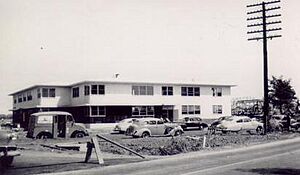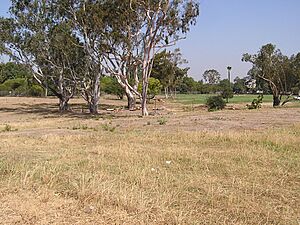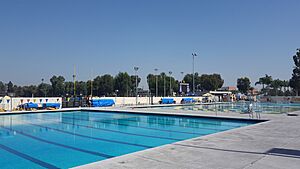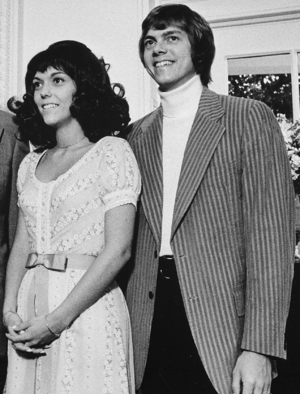California State University, Long Beach facts for kids
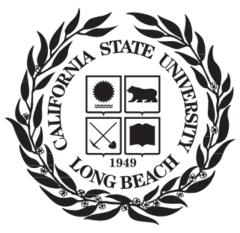 |
|
|
Former names
|
Los Angeles-Orange County State College (1949–50) Long Beach State College (1950–1964) California State College, [at] Long Beach (1964–1972) |
|---|---|
|
Motto in English
|
"Where California Dreams" |
| Type | Public research university |
| Established | 1949 |
|
Parent institution
|
California State University |
| Accreditation | WSCUC |
|
Academic affiliations
|
|
| Endowment | $132.9 million (2023-24) |
| Budget | $581.1 million (2024-25) |
| President | Jane Close Conoley |
| Provost | Karyn Scissum Gunn |
|
Academic staff
|
2,583 |
| Students | 41,189 (fall 2024) |
| Undergraduates | 35,843 (fall 2024) |
| Postgraduates | 5,346 (fall 2024) |
| Location |
,
United States
33°46′59″N 118°06′46″W / 33.783022°N 118.112858°W |
| Campus | Large city, 323 acres (131 ha) |
| Newspaper | Long Beach Current |
| Colors | Black and gold |
| Nickname |
|
|
Sporting affiliations
|
|
| Mascot | Elbee |
California State University, Long Beach (CSULB) is a large public university in Long Beach, California. It is also known as Long Beach State University (LBSU), especially for its sports teams. The campus is huge, covering 322 acres, which makes it the second largest in the California State University system.
About 35,843 undergraduate students and 5,346 graduate students attend CSULB. The university offers many different programs, including master's degrees and special certificates. It also has four doctoral programs, which are the highest degrees you can earn. CSULB is known for its research activities.
The university is home to one of the biggest public art schools in the United States. It is also recognized for serving a diverse group of students, including those of Hispanic, Asian American, Native American, and Pacific Islander backgrounds.
Contents
History of CSULB
How the University Started
California State University, Long Beach began in 1949. It was created by California governor Earl Warren. The goal was to provide education for the many people moving to Orange and Southern Los Angeles counties after World War II.
The school was first called Los Angeles-Orange County State College. It started with just 25 courses and 13 teachers. Classes were held in two apartment buildings in Long Beach.
Growing and Changing Names
In 1950, the college bought a 322-acre plot of land for its permanent campus. The city's residents voted strongly for this purchase. The school was then renamed Long Beach State College. Student numbers quickly grew after this move.
Carl W. McIntosh became the second president in 1959. During his time, the number of students jumped from about 10,000 to over 30,000. He also added many new courses and built 30 new buildings. McIntosh helped keep the campus peaceful during a time when many colleges had protests.
In 1964, the school's name changed again to California State College at Long Beach. Then, in 1968, it became California State College, Long Beach. This change made it a closer part of the California State College system.
Art and University Status
In 1965, CSULB hosted the first International Sculpture Symposium in the United States at a university. This event brought international and American sculptors to create art on campus. It even got attention from major newspapers.
In 1972, the school officially became a university. This happened because of its large number of students, many graduate programs, and diverse subjects. Later that year, the campus opened a huge six-story library. It was the largest library in the CSU system at the time.
Scholarships and Mascots
In 1995, President Robert Maxson started the President's Scholars Program. This program gives full four-year scholarships to top high school students. It helps them pay for tuition, books, and housing.
In 2020, CSULB introduced its new shark mascot, Elbee. Students helped choose the shark as the new mascot. Even though Elbee is a shark, the university's sports teams are still called "Beach Athletics."
Exploring the Campus
The CSULB campus is very large, covering 323 acres. It has 84 buildings and is located about 3 miles from the Pacific Ocean. The campus is at 1250 Bellflower Boulevard in Long Beach.
Campus Design
The buildings on campus mostly follow a simple, modern design style. This style is called the International style. It was mainly designed by architect Edward Killingsworth. The campus has won awards for its design and beautiful gardens. Trees are often planted to blend with the buildings, like the ficus trees at the theater entrance.
Famous Campus Spots
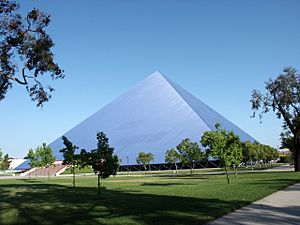
- University Student Union (USU): This is a three-story glass building in the middle of campus. It has offices, a study lounge, a food court, a bowling alley, an arcade, and a movie theater. It's a popular spot for students to relax and hang out.
- Rec and Wellness Center: This is a large athletic center that opened in 2010. It has areas for fitness classes, courts for sports like volleyball and basketball, rock climbing walls, and an indoor track. Students use it for exercise and fun.
- Walter Pyramid: This is a very famous building on campus. It's an eighteen-story pyramid-shaped sports complex. It can hold over 5,000 fans for basketball and volleyball games. Inside, parts of the stands can even lift up to make room for more courts! It's also home to the Southern California Summer Pro League, where future NBA players show their skills.
- University Art Museum: This museum has a collection of abstract paintings and an outdoor sculpture garden. It was the first museum in the CSU system to be officially recognized.
- Carpenter Performing Arts Center: This theater has 1,074 seats and is named after famous alumni Richard and Karen Carpenter. It hosts many shows and performances.
- Earl Burns Miller Japanese Garden: This is a peaceful and beautiful garden on campus. It has a large pond filled with koi fish and is a great place for quiet reflection.
Puvungna: A Sacred Site
The university campus is built on an ancient village and burial site called Puvungna. This site is very important and sacred to the Tongva and Acjachemen Native American people. In 1974, the 22-acre site was added to the National Register of Historic Places.
There have been efforts to protect this site. In 2019, the university put dirt and equipment on the site for a new building. This upset the Tongva and Acjachemen people, who worked to protect the land from further damage. The site remains a natural area today.
Being Green on Campus
CSULB works to be environmentally friendly. In 2007, solar panels were installed on some buildings to use clean energy.
The Environmental Science & Policy Club helps raise awareness about the environment. They organize beach clean-ups, hikes, and plant restoration projects. They also host an annual Earth Week celebration with movies and speakers. The university also has student-led gardens that promote organic farming.
The university has a program to save energy by using smart technologies in its buildings.
Desert Studies Center
CSULB is part of a group of universities that run the Desert Studies Center. This center is located in the Mojave Desert in California. It gives students and researchers a chance to study and experience the desert environment.
What You Can Study
CSULB has several colleges where students can study different subjects:
- College of the Arts
- College of Liberal Arts
- College of Natural Sciences and Mathematics
- College of Business
- College of Education
- College of Engineering
- College of Health & Human Services
- College of Continuing & Professional Education
These colleges offer many different degrees. You can earn 81 bachelor's degrees, 67 master's degrees, and three doctoral degrees.
Getting Into CSULB
| 2024 | 2023 | 2022 | 2021 | 2020 | |
|---|---|---|---|---|---|
| Applied | 83,952 | 79,658 | 74,704 | 67,092 | 67,402 |
| Admitted | 38,855 | 37,548 | 29,861 | 31,448 | 28,400 |
| Enrolled | 6,482 | 5,756 | 5,366 | 4,865 | 4,908 |
| Admit rate | 47.5% | 47.1% | 40% | 46.9% | 42.1% |
| Average GPA (weighted) | 3.93 | 3.95 | 4.0 | 3.92 | 3.92 |
California State University, Long Beach is a very popular school. It receives over 80,000 applications each year. In Fall 2024, more than 83,000 students applied for their first year. About 38,000 of them were accepted. The average GPA for accepted students was 3.93.
For master's and doctoral programs, the school received over 10,733 applications in Fall 2023. About 3,270 applicants were accepted into these programs.
University Rankings
CSULB is recognized for its diversity. In 2021, The Wall Street Journal/Times Higher Education ranked CSULB 8th in the nation for Campus Diversity. This ranking looked at how diverse the students and teachers were.
The university also ranks well in other areas. For example, in 2024-2025, USNWR ranked CSULB:
- 3rd for Top Performers on Social Mobility (helping students from all backgrounds succeed).
- 52nd among Top Public Schools.
- 23rd for Best Undergraduate Engineering Programs.
Student Life
| Race and ethnicity | Total | ||
|---|---|---|---|
| Hispanic | 50% |
|
|
| Asian | 22% |
|
|
| White | 15% |
|
|
| Black | 4% |
|
|
| Two or more races | 4% |
|
|
| Foreign national | 2% |
|
|
| Unknown | 2% |
|
|
| Economic diversity | |||
| Low-income | 50% |
|
|
| Affluent | 50% |
|
|
Student News and Magazines
Students at CSULB create three main publications:
- Long Beach Current: This is the campus newspaper. It started in 1949 and was one of the first college newspapers to have an online version in 1994. It publishes several times a week during school semesters.
- 22 West Magazine: This magazine is partly funded by students. It focuses on being an alternative voice on campus.
- DIG Magazine: This campus magazine covers interesting people and groups in the community. It also discusses topics that students care about.
Campus Radio Stations
- KKJZ 88.1 FM: The university owns the license for this non-commercial radio station. It plays jazz and blues music.
- 22 West Radio: This is a student-run internet radio station at CSULB. It has been around since the 1970s and is operated by the Associated Students, Incorporated at CSULB.
Student Recreation and Wellness Center
The Student Recreation and Wellness Center is a large building that opened in 2010. It cost $70 million to build. It's located on the northeast side of campus and offers many ways for students to stay active and healthy.
Student Clubs and Groups
CSULB has many national sororities and fraternities. These are social organizations that students can join to make friends and get involved in campus life.
Sports at Long Beach State
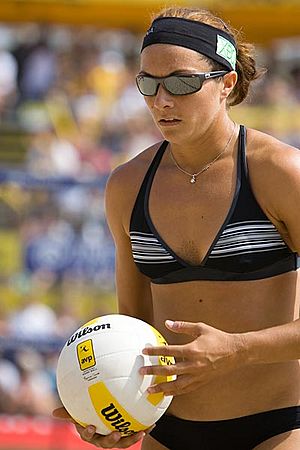
Long Beach State competes in NCAA Division I, which is the highest level of college sports. They have 18 sports teams. These include teams for baseball, cross country, softball, track and field, and golf. They also have men's and women's teams for basketball, volleyball, and water polo.
The university is a founding member of the Big West Conference. The school's sports teams are officially called "Beach" since the 2020–21 school year. You can often see the cheer "Go Beach!" on campus products and on the large water tower near the campus entrance.
The school colors are black and gold. They were changed in 2000 from the original brown and gold.
Long Beach State is famous for its women's volleyball teams. They have won three national titles in 1989, 1993, and 1998. The 1998 team was the first in NCAA Division I history to have a perfect undefeated season. The men’s volleyball team has won four national championships, including in 2025. A very famous alumna is Misty May-Treanor, who won three Olympic gold medals in Beach Volleyball.
Because it's close to California State University, Fullerton, the two schools have a strong sports rivalry, especially in baseball.
Famous People from CSULB
CSULB has more than 320,000 alumni, which are former students. Many of them have become very successful in different fields.
In Movies and TV
Many alumni have worked in movies and television.
- David Twohy helped write the movie The Fugitive.
- Linda Woolverton wrote the screenplays for Disney animated films like Beauty and the Beast and The Lion King.
- J. F. Lawton wrote the screenplay for Pretty Woman.
- Mark Steven Johnson has written and directed movies like Daredevil and Ghost Rider.
- Steven Spielberg (who got his degree in 2002) won two Academy Awards for Best Directing for Schindler's List and Saving Private Ryan. He also directed famous movies like Jaws and Jurassic Park.
- John Dykstra won two Oscars for his special effects work on Star Wars and Spider-Man 2.
- Deborah L. Scott won an Oscar for costume design for the movie Titanic.
- Chris Carter created the TV series The X-Files.
- Steve Martin, a famous comedian, was inspired to become a professional comedian after taking philosophy classes at the university.
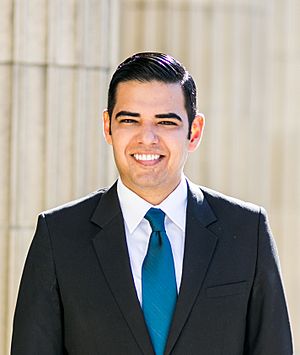
In Politics
Former mayors of Long Beach, Robert Garcia and Beverly O'Neill, are alumni of CSULB. Robert Garcia is also a US Congressman.
In Sports
Many alumni have become successful athletes.
- Baseball players like Jason Giambi, Evan Longoria, and Troy Tulowitzki have played in the Major League Baseball All Stars games.
- Matt Duffy won the World Series with the San Francisco Giants in 2014.
- Golfer Mark O'Meara won major tournaments like the Masters Tournament.
- Craig Hodges won two NBA Championships.
- Terrell Davis won two Super Bowl championships and is in the Pro Football Hall of Fame.
- Pat McCormick won four gold medals in diving at the Olympics in 1952 and 1956.
- Misty May-Treanor won three gold medals in women's beach volleyball at the Olympics in 2004, 2008, and 2012.
- High Jumper Dwight Stones set a World Record while a student and won bronze medals at the Olympics.
In Music
Karen Carpenter and Richard Carpenter from the famous music group the Carpenters are former students. The Carpenter Performing Arts Center on campus is named after them. They sold over 100 million records and won three Grammy Awards.
See also
 In Spanish: Universidad Estatal de California, Long Beach para niños
In Spanish: Universidad Estatal de California, Long Beach para niños


